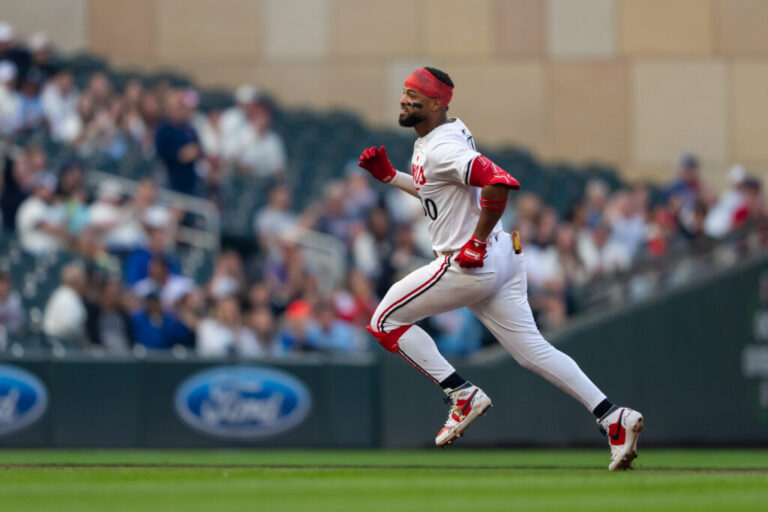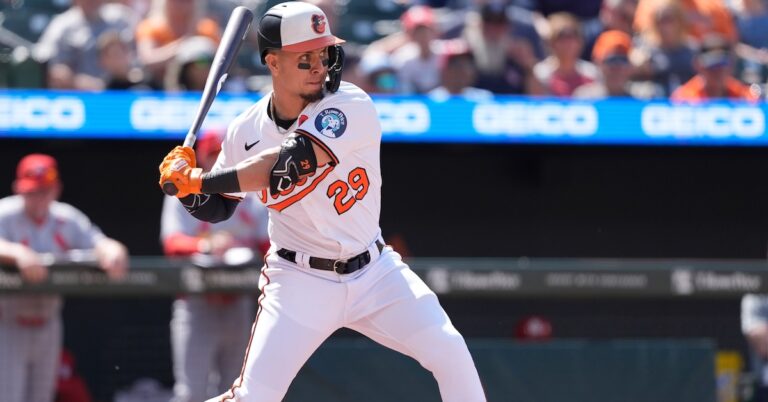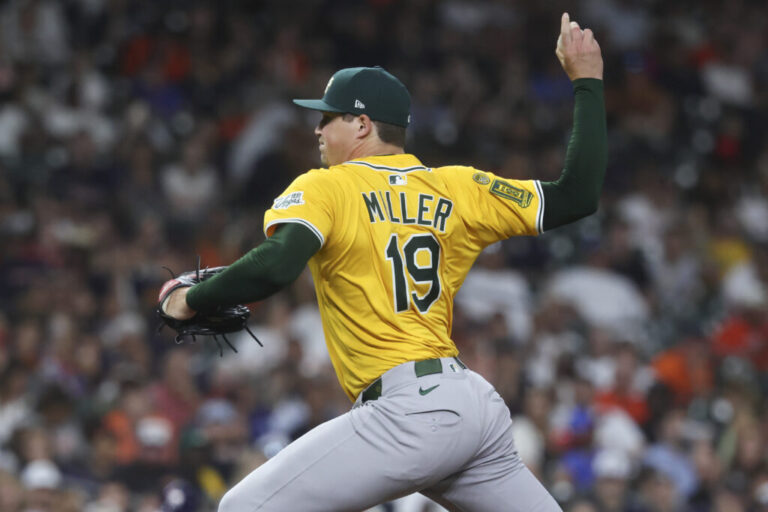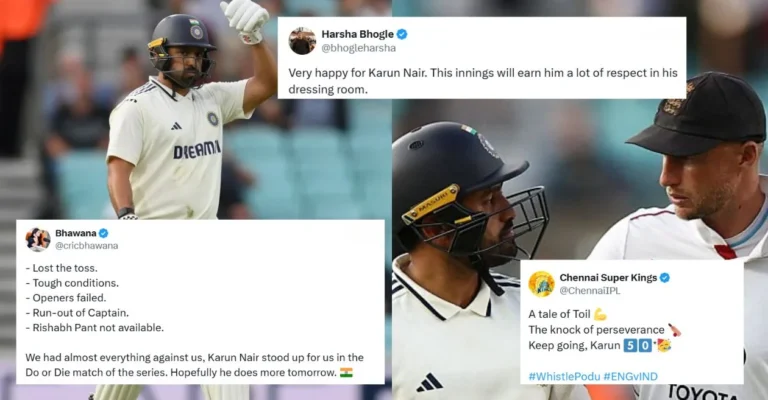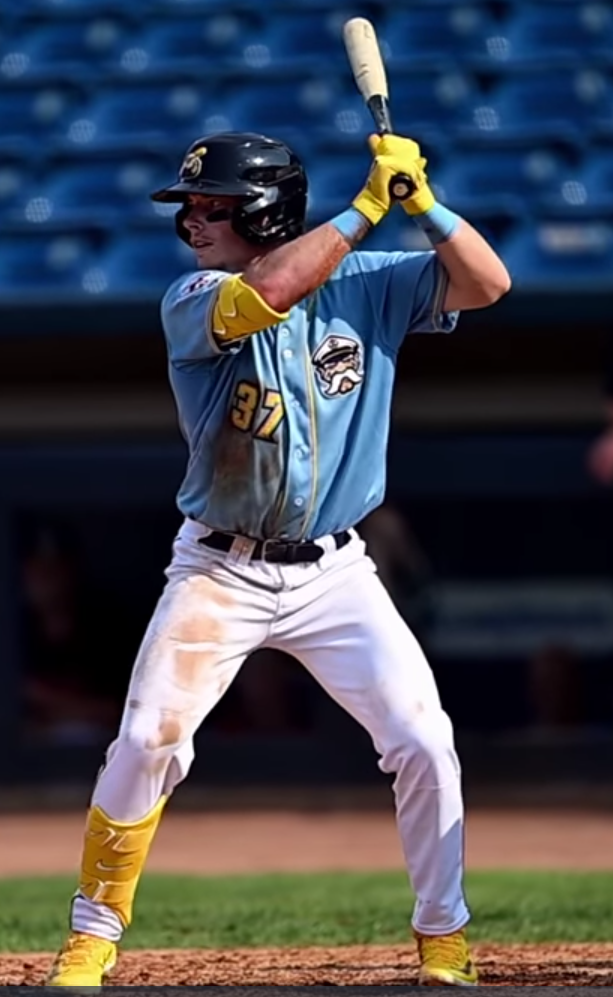
Travis Bazzana playing for the Cleveland minor league affiliate, the Lake County Captains; CC by License 2.0
Another draft cycle has come and gone, and many of the picks from this past summer’s draft class have begun their professional career. Prior to the draft, our team worked on a list of the top 15 hitters that would be available, which can be found here. Today, we’ll be checking in on some of the collegiate bats that we highlighted in that article that have been competing in the minor leagues. Unfortunately, we don’t have too much to go off of in terms of batted ball data for the majority of these guys, but they have played enough games to make some of these trends statistically significant.
Travis Bazzana, Guardians, A+
The first overall pick has had a fairly successful transition into pro ball, though he has struggled a bit. In A+, he’s currently hitting .238 with a .765 OPS. He’s posting a .340 wOBA, which is a tick above average for the level. He’s still posting the same impressive contact numbers that he posted throughout his time at Oregon State, but he is being a bit more passive at the plate, only swinging the bat 38.4% of the time on pitches in general and under 60% on pitches within the strike zone. The Guardians are more than likely making a conscious decision to work with Bazzana and tap into his plus pitch recognition and swing decisions. With the success that the big league club is having, they are in no rush to fast-track him to the majors, and now is a great time to take a step back and work on the approach during his first season of pro ball. Expect the swing decisions to become more aggressive at the beginning of next year, which should allow his raw power to stand out a bit more. The bat to ball skills have remained consistent during the switch to pro ball, highlighted by his 81.4 zCon% and absurd 71.4% oCon%. There’s obviously still some development and aggressiveness that needs to ramp up for him, but Bazzana has proven himself capable and deserving of the first overall pick.
Charlie Condon, Rockies, A+
Charlie Condon had a monstrous year at the University of Georgia in 2024, but his performance so far in pro ball has left much to be desired. At the 100 at-bat mark in A+, Condon is hitting .180 with one home run and a measly .518 OPS. Much of this has to do with some serious swing and miss issues that raise some pretty bright yellow (for now) flags about his ability to consistently handle advanced pitching. He’s whiffing at over a third of the pitches that he sees, his oCon% is 25.9, and he’s posting a 34:4 K/BB ratio. His zCon% is also a bit alarming at 73.5%. To put this into comparison, that number was 89.6% during his collegiate season. Some of these underlying issues could be attributed to fatigue. He had a long collegiate season and not much of a break prior to beginning his professional career. But, in the video that I have seen, he looks fairly uncomfortable in the box and has been unable to consistently get the ball in the air, an issue that showed up minorly at UGA that I raised some slight concerns about in the article mentioned above. Hopefully for Condon and the Rockies, the struggles will improve after his first professional offseason of development and a bit of rest. The raw power is still, obviously, incredibly attractive, but unfortunately, not very effective if he is not going to put the ball in play in the air.
JJ Wetherholt, Cardinals, A
Fortunately, we do have Statcast data on Wetherholt for his time in A ball so far. Through 105 at bats, Wetherholt is slashing .295/.405/.400 with 2 home runs and a .361 wOBA. Really all of the underlying metrics on him look good as well. He’s not chasing a ton, he’s showing off the impressive bat-to-ball abilities consistently, and he’s shown above-average raw power, evident by the 105.3 90th% EV and 109.2 max EV. He’s walking at a higher rate than he’s striking out, and he’s being selective with his swing decisions. This places him in advantage counts and allows him to use both his pure, advanced hit tool and his above-average power to punish opposing pitchers. Pitchers have struggled to find a good way to attack him at the plate, as he has posted really solid numbers against all types of pitches. Against breaking balls, he’s posting an absurd .674 xwOBACON (essentially measures how much damage he’s expected to produce when he does make contact), though his whiff rates on these pitches is hovering right around 30%. He produces similar numbers against fastballs, and doesn’t swing and miss at them a ton, posting a 17.1% whiff rate. Offspeed pitches, such as changeups, may be the way to attack him as he doesn’t produce as much damage, but even against those he’s only swinging and missing 13.3% of the time. Wetherholt is a nightmare matchup for pitchers in A-ball currently, and he’s showing why he was touted as the best prospect in the class before his hamstring injury.
Jac Caglianone, Royals, A+
Caglianone has been fairly impressive at the start of his professional career. Through 115 at-bats, he’s slashing .241/.302/.388 with 2 home runs and a .298 wOBA. The production and general power numbers may seem a bit down, but this is natural as one enters professional baseball. The power is still very much there, and will begin to show up as he becomes acclimated to professional pitching. He’s showing similar aggressiveness to what he showed at Florida this past year, but the whiff rates don’t look that bad as they’re sitting at 26.4% currently. He’s making contact in the zone consistently, shown by the 82.8% zCon rate, but the chase is currently sitting at 45.6%, which is actually increased from the 38% clip that he posted during his season at Florida. This is, somewhat, mitigated by his ability to cover outside of the zone with his large frame and long bat path. He’s making contact on pitches out of the zone 61.3% of the time, which is a solid number but still not enough to completely overcome the chase issues. I would love to see him swing less as he finishes up the season. This would allow him to, hopefully, develop a better feel for the strike zone and help tame his approach a bit.
Nick Kurtz, Athletics, AA
Kurtz has only played in 12 professional baseball games, but after a week of A ball games where he hit .400 with 4 home runs, he’s been promoted to AA. Going into the draft, I felt as if Kurtz’s mature approach, above-average bat-to-ball skills, and plus power would translate quickly to pro ball, and he has had about as seamless of a transition as one can have. There isn’t enough data to really identify any meaningful trends yet, but his sub 20% whiff rate so far is certainly promising. He hasn’t slugged much in his 5 games at the AA level, but again, it’s far too early to be concerned about that fact.
James Tibbs III, Giants, A+
Through 108 at-bats, Tibbs is slashing .241/.293/.343 with 2 home runs and 5 doubles. While it is still early, Tibbs has run into some real issues at the plate. He currently has a 36:8 K/BB ratio, is posting a whiff rate just under 33%, and has a measly 71.2 zCon%. On the bright side, he’s not expanding the zone much, but the inability to walk coupled with the swing and miss issues has me fairly concerned at the moment. He’s also not impacting the baseball and producing damage really at all as highlighted by his .208 wOBA, which is far below average. This creates a nasty three-headed beast of underlying yellow/red flags so far in pro ball that are troubling, however, I’m not all the way out on him, as we’ve seen him be a consistent performer at all levels. The adjustment to pro ball is a massive adjustment, and a full offseason should allow him and the Giants to really work on some of these issues and hopefully get back to the consistency that he showed in his collegiate career.
Smith has been, perhaps, the best and most consistent performer from this draft class so far. Through 96 at-bats, he’s slashing .323/.412/.635 with 7 home runs. The swings have looked extremely comfortable, confident, and explosive. He’s producing at a high level, shown by his .392 wOBA, which is comfortably above-average. Unfortunately, there’s no batted ball data available on him yet, but the underlying metrics look incredibly promising as well. He’s only swinging and missing just over 20% of the time and is posting a 87.1 zCon%, both good signs and above-average. However, he does still have a bit of an issue with expanding the zone, swinging outside of the zone at a 33.6% rate. This hasn’t seemed to slow him down yet, but it has limited his walk numbers and will only continue to be exposed more and more as he progresses up in pro ball.
Christian Moore, Angels, AA
As is typical of the Los Angeles Angels, Moore was the first player taken in the 2024 draft to reach AA, though it wasn’t without merit. In 2 games in A ball, Moore collected 6 hits, including 2 doubles and a home run. His success has continued in AA for the most part, where he’s slashing .302/.355/.512 with 5 home runs in 86 at-bats. There is a non-zero chance that he gets some at-bats with the big league club this season, but that’s just a product of the organization and their philosophies. Under the hood, I do have some concerns about Moore and his swing and miss issues. He’s currently posting a 37.6 whiff% in AA to go along with a 30% strikeout rate and a 64.4 zCon%. He’s also expanding the zone often, posting a 39.4 chase%. Even though he is producing, these metrics do concern me considerably. The pitching is only going to continue to improve as he moves up the ranks, and these issues will need to be resolved or at least mitigated before he’s ready to contribute at a high-level in the big leagues.
